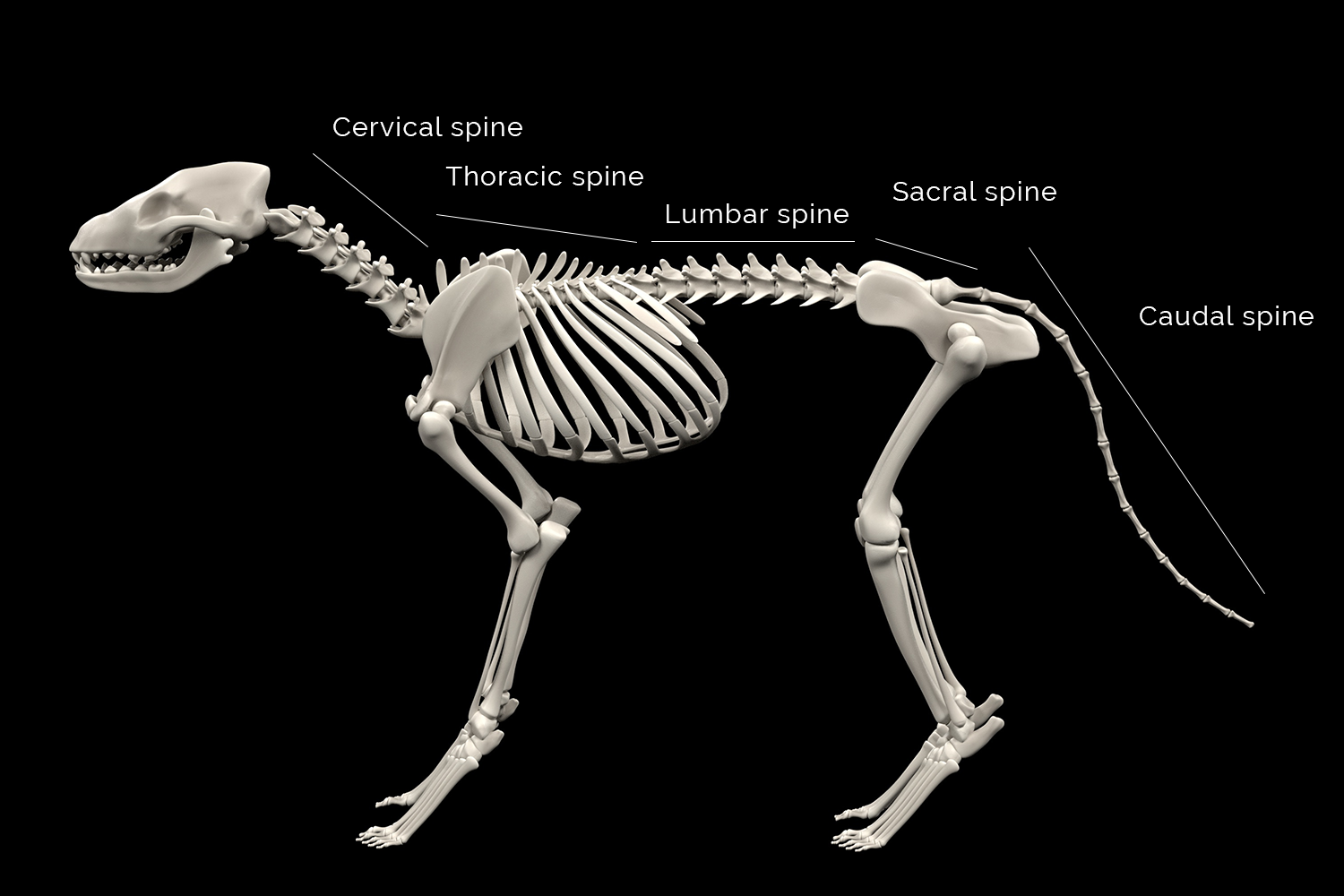Like us, dogs commonly suffer from back pain
but unlike us, they can’t tell anyone about it – while acute back pain can be easy to pick, chronic back pain often goes unnoticed.
Dogs with acute back pain appear stiff and often yelp when moving or being touched. They can also tremble, pant and seem unsteady on their legs. Chronic back pain on the other hand may only show up as talking more time than usual to get comfortable.
The anatomy of your dog’s back
Before we look at how things go wrong, it can help to know what’s right. So let’s look at what makes up a normal back.
Bones
The spine (or backbone) is made up of a series of small bones called vertebrae, which form a bony tube that protect the spinal cord. Dogs have:
7 cervical (neck) vertebrae
13 thoracic vertebrae
7 lumbar vertebrae
3 sacral vertebrae
a variable number of caudal (tail) vertebrae
The vertebrae are all shaped a bit differently, but generally they all have a solid section at the bottom (the vertebral body), a hole above that (where the spinal cord goes) and then some spiky bits that go up and out to the sides (called the spinous processes and transverse processes).
The vertebrae connect to each other by two sorts of joints:
discs – these are cartilage cushions between the vertebral bodies. Each disc has a thick fibrous outer rim (annulus fibrosus) and a soft jelly centre (nucleus pulposus) as well as a cartilage cap on each side that joins it to the bone
facet joints – these are small synovial joints between the vertebrae that allow the spine to bend and flex
Nerves
The spinal cord (running down the middle of the vertebrae) is part of the central nervous system (CNS) – it’s essentially an extension of the brain. As well as the spinal cord, there are also spinal nerves that branch off and exit out the sides between the vertebrae. Dogs have 36 pairs of spinal nerves.
Spinal nerves carry motor, sensory and autonomic signals between the spinal cord and the body.
muscles, tendons and ligaments
There are two types of back muscles:
epaxial muscles – which sit above the transverse processes and extend the spine
hypaxial muscles – which sit below the transverse processes and flex the neck and the tail
Tendons connect muscles to bones and ligaments connect bones to bones. The spine has ligaments that run below and above the discs (called the ventral and dorsal longitudinal ligaments respectively). These run the entire length of the backbone and are particularly nerve rich.
Any of these parts of the back can cause pain.
What causes back pain?
In dogs, there are several different causes of back pain. Here’s a brief overview of some of them.
Disc disease
The most common cause of back pain is intervertebral disc disease (IVDD). This is otherwise know as a herniated or bulging disc.
There are two types of disc herniations in dogs:
type I (or Hansen type I) – is a degenerative process whereby the jelly centre of the disc dries out and hardens. It can then suddenly break (or extrude) through the fibrous ring and end up pressing into dorsal longitudinal ligament and possibly the spinal cord as well. This tends to occur in younger dogs (especially long backed, short legged ones), although it can happen to any dog
type II (or Hansen type II) – this is also a degenerative process but it involves weakening of the fibrous ring around the disc and then through normal vertebral movements, the disc bulges (or protrudes). The pressure on the ligament and spinal cord occurs more slowly. This one tends to affects older large breed dogs (especially German Shepherd Dogs)
The point of telling you about these is not so much you need to know the difference, it’s just to highlight that discs don’t herniate through some special activity. They simply degenerate over time and then go pop.
Your dog doesn’t hurt her back doing something. The disc joints in her back are either diseased or they’re not.
The symptoms of IVDD depend on the where the bulge occurs and what it presses on. In mild cases, there may just be some pain over the site of the herniation. In severe cases, the spinal cord may be compressed enough to cause paralysis. A grading system has been developed for dogs:
Grade 1 (Pain only) – affected dogs are able to walk normally but show signs of pain (eg reluctance to move, reluctance to jump, shivering, crying, muscle spasms and/or a tense abdomen). It usually resolves within a few days
Grade 2 (Ambulatory paresis) – affected dogs display pain and can walk but are weak and wobbly in the back legs. They may cross their back legs when walking, splay out, knuckle over or stumble in their back legs
Grade 3 (Non-ambulatory paresis) – affected dogs can move their legs and wag their tails but are not strong enough to support their own weight and walk
Grade 4 (Paralysis) – affected dogs have no voluntary movement in their back legs
Grade 5 (Paralysis with no ‘deep pain’) – these dogs are unable to move or feel their back legs
Grades 4 and 5 are generally considered surgical. Lower grades are usually managed medically, but may be considered for surgery if not responding to treatment.
About 15% of herniations occur in the neck, with the rest occurring in the lower thoracic and upper lumbar spine. The most common sites for disc herniation are between the 11th and 12th thoracic vertebrae and between the 2nd and 3rd lumbar vertebrae.
MUSCLE STRAIN
When we find spasming back muscles in dogs, it’s very often due to IVDD – the herniated disc triggers the spasm.
It is possible for dogs to strain their back muscles through overexertion or injury. This usually settles down quite quickly with rest.
INFECTION
Dogs can get bacterial or fungal infection in their discs. This is called diskospondylitis. It’s most common in young, large breed (and male) dogs.
FRACTURES
Fortunately, these don’t occur commonly in pets. The two main causes are accidents (especially being hit by a car) and spinal cancers that weaken the bone.
Hemivertebrae
Bulldogs, Boston Terriers and Pugs (ie bracycephalic breeds with a screw tail) can suffer a congenital abnormality called hemivertebrae, where some bones of the spine are abnormally shaped. The abnormal shape means they don’t align correctly, which can lead to instability of the spinal column and possibly also damage to the spinal cord or the spinal nerves.
Meningitis
The spinal cord and brain are covered by a membrane called the meninges. Inflammation of the meninges is called meningitis. You might be familiar with meningitis when it comes to the brain, but spinal meningitis is less well known.
Meningitis may be caused by an infection or by an inflammatory disease (eg steroid-responsive meningitis, granulomatous meningoencephalitis).
Stenosis
Stenosis of the spine usually occurs in the lumbosacral area and refers to a narrowing of the spinal canal with a slow compression of the spinal cord. German Shepherd Dogs are most commonly affected.
CANCER
Cancers can grow anywhere in the body including the vertebrae, spinal cord, nerve roots or any of the soft tissues of the back.
How do we diagnose back pain?
Before we start a physical examination, it’s important to watching the dog walk around the consult room. How she moves her head, how freely her limbs move, whether she’s wobbly or weak, how easily she sits/gets up all tell us a lot.
We then look for painful areas along the spine by pressing along the whole length. We start gently and only increase the pressure if there is no strong pain reaction and then we’re looking for more subtle pain. Signs of pain include yelping, turning around, going very still, changing facial expression, licking lips or dipping away from the pressure.
We check for involvement of the spinal cord by testing different reflexes. An early sign of pressure on the spinal cord is loss of a reflex called conscious proprioception. Conscious proprioception is the ability to sense where one’s feet are and orient them properly. You’ll see us place your dog’s feet over so that the top of the foot is on the ground and then check to see if she replaces her foot in the proper position, and how long that takes. Nerves responsible for conscious proprioception are located on the outside of the spinal cord so when the disc herniates, these nerves feel the pressure first.
Depending on what we find, we may consider further investigation.
Plain X-rays
X-rays aren’t great at looking at the soft tissues of the back (ie the spinal cord, spinal nerves or discs) but they are good for looking at bones. The can rule out obvious spinal issues such as fractures or dislocations, bone tumours and calcified discs. They can also show collapsed disc spaces where a herniation has occurred.
Taking X-rays may require general anaesthesia or sedation to get proper relaxation of the muscles and because moving a dog with a painful back is just mean!
We can do plain X-rays in-house and on the same day as the consultation.
Advanced imaging
Advanced imaging refers to CT or MRI and when we’re talking about spines, it often includes
myelography as well. A myelogram is where an iodine-based dye is injected around the spinal cord. The image of the dye can be seen to narrow at the area of spinal cord compression.
As a general rule, advanced imaging is only done when surgery is being considered. Advanced imaging is always done under general anaesthesia (pets can’t be asked to lie still and hold their breath). If a disc herniation (or other surgical condition) is detected, the patient typically then goes directly to surgery without waking from anaesthesia.
We refer patients for advanced imaging and spinal surgery.
What is the treatment for back pain?
The first treatment for any painful condition is analgesia. For more info on pain and pain management see our entry on Pain in dogs.
Other treatment depends on the cause of the pain.
As far as the most common cause of back goes (ie disc disease), additional therapy depends on severity of the pain and whether or not the spinal cord is affected. The options fall into two categories: medical (conservative) or surgical. We’ll only briefly cover these here.
The general rules for choosing between medical and surgical options are:
if the patient is paralysed (ie grade 4 or 5), surgery gives best chance of recovery
if the patient can walk (ie grade 1 or 2), medical treatment is appropriate (unless the pain is severe and/or cannot be controlled well enough with analgesic drugs)
the longer the patient has been paralysed for, the less successful surgery is likely to be
These rules need to be balanced against your preferences and needs and your dog’s situation. Spinal surgery costs somewhere in the vicinity of $5000 and there can be an extended period of recovery.
Medical therapy
Medications are given to relieve pain and reduce inflammation but there is no magical medication that fixes a herniated disc. A herniated disc stays herniated. With time, the damage done by the moving disc is repaired by the body and the patient recovers..
Therefore, strict rest is considered a very important component of medical therapy. The idea is that if the dog is kept still, the disc will stop moving and the damage will heal. This typically involves about 2–3 weeks of being confined and only going out to go to the toilet and then going straight back to bed.
Surgical therapy
If surgery is required, we will refer the patient to a specialist.
There are several different types of spinal surgery (eg hemilaminectomy, ventral slot). All aim to relieve the pressure on the spinal cord by removing the herniated disc material.








